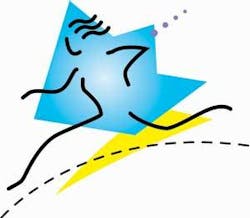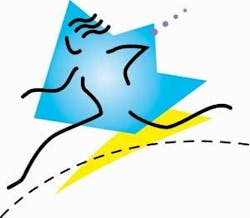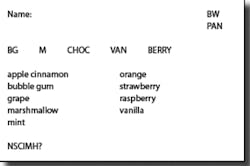Shortcuts
by Cathy Hester Seckman, RDH
Yada, yada, yada, blah, blah, blah ...
That might be a little irreverent, but it serves a purpose in saving time in a dental operatory. At one office, colorful stamps have replaced the handwritten notes and stickies that used to adorn the fronts of patient charts.
In this privacy-conscious office, a “Yada” stamp tells the staff that HIPAA forms have been completed. Red balloon stamps on the outside of a chart indicate a latex allergy. Green grass stamps alert everyone to environmental allergies. A red “P” means a penicillin allergy, and a red heart indicates a need for premedication.
Shortcuts? Sure. The stamps keep necessary, pertinent information right out front while still maintaining patient privacy. Efficiency expert Laura Stack, MBA, CSP, says in her book, Find More Time, that the secret to reducing paperwork is to handle it only once.
It’s more efficient, therefore, to glance at a stamp than to repeatedly riffle through the chart at every visit to find the necessary information. Shortcuts such as these are small and save only seconds at a time, but when you add enough shortcuts together, they can make for a supremely efficient day.
Let’s say there are two types of operatory shortcuts: those that deal with paper, charting, and routing, and those that deal with instruments and supplies. The example above is the first kind. It shortens the amount of time a clinician has to spend with the chart. Even in a paperless office, judicious use of paper can still make for a good time-saver.
Here’s a paper shortcut that can be useful in any office with assisted hygiene. At my busy pediatric office, we use customized, three-by-four-inch routing slips like the one shown in Figure 1. A dozen of these blocks of type fit on a sheet of paper, which we copy and cut apart during downtime.
Each child’s first stop is the toothbrushing room, where he or she gets a new brush and chooses the flavors desired for prophy paste (top row of slip) and fluoride (in columns). As the child is debating the merits of apple cinnamon over raspberry, an assistant writes the patient’s name on the slip, and circles BW (bitewing) or PAN (panoramic) if either is scheduled.
The initials at the bottom, NSCIMH, stand for “no significant change in medical history.” If there is no change, the line is crossed out. If there has been a change, the slip provides room to write down the changes. The assistant also makes a note of the person she talked to about the medical history: “Mom,” “Dad,” “Grandpa,” “caregiver,” and sometimes, for older teens, “self.”
As the child goes to the chair, the assistant takes the routing slip to a central cupboard and dispenses the chosen flavors of paste and gel. She puts them on the tray, leaves the slip with the chart, and the hygienist then has everything she needs to get started.
Here’s one more paper shortcut that would work in any office. How do you know when it’s time to sharpen instruments? Whose turn is it? And which instruments have already been done? First, decide on a sharpening interval that works for your type of practice. Then, if you haven’t done it already, code your instrument setups with colored rubber rings or tape.
Next, make up a chart like the one shown in Figure 2, and tape it inside a cupboard door. Use a full sheet of paper, and fill it with blank rows. Write dates and names in each block, and no one will have to waste time wondering about sharpening.
Charts and forms like these can be kept in a manual or on the office computer in a word processing file, and copied or printed when needed.
There are some basic instrument/supply shortcuts. Your office probably already uses some of these, making you more efficient than you thought you were.
- Set up trays in advance with instruments and disposable products, and keep supplies like fluoride and floss threaders within easy reach. Every time you have to get up and leave a patient to retrieve something, you lose valuable time
- If instruments are kept in cassettes and there is no storage space for trays, package the disposable products together so they can be ready in advance. Gather together barriers, gauze, a saliva ejector, a prophy angle, prophy paste, and floss in zippered bags that are stored at chairside. Then, as soon as the room is cleaned, you can pick up a cassette and a zippered bag and be ready to go.
- Here’s a guaranteed timesaver for disposables: Don’t use the sticky plastic film that comes in a roll. Think how much time you waste prying it off the light handle after each patient. Instead, use soft plastic sleeves made especially for those handles.
- Assemble patient goodie bags with toothbrush, floss, mouthrinse sample, and toothpaste during downtime and keep them in a cupboard or drawer.
- Bundle X-rays in packs of 18, and add bitewing tabs to films in advance, then bundle in packs of two and four.
- If your office doesn’t have a hygiene policy manual, write one. A manual - individual pages in a three-ring binder - can include information on issues like frequency of X-rays, waterline maintenance, protocol for soft tissue management protocol, hazard exposure, and administration of premedication. Instruction booklets for ultrasonic instruments and computer equipment should be in the manual. You can also keep master copies of routing slips like the ones in Figures 1 and 2. For maximum efficiency, try to standardize your morning routine and put a list in the manual: “Turn on processor, fill water bottles, check supplies, etc.” Including photographs of tray setups can make things easy for newcomers and temps. With a manual, anyone who has a question can easily and quickly find the answer with minimal disruption to the flow of productivity. Don’t forget to put a table of contents page at the front of the manual.
- Label everything. Labels not only save time for employees, they can be a lifesaver for a temp worker or a new hire. “Every cabinet and every drawer in my office has a label,” says Dr. Catrise Austin, owner of VIP Smiles in New York, N.Y. “Inside the cabinets and drawers, supplies and instruments are stored in plastic bins from a dollar store, so that everything has a specific home. Every operatory is identical, so that even a temp can see exactly where everything goes. In the lab, all the dry goods are kept together and clearly labeled for efficiency. Even at the front desk, all the cubbyholes are labeled.”
- Automate the ordering process as much as possible. Austin’s office uses an Excel spreadsheet that lists supplies and their order numbers, and includes a column for quantities. “Every two weeks, we print that out and highlight or circle what we need. We write in the quantity and fax the sheet to our rep.”
- Time yourself on routine procedures. One timesaver that Austin especially likes took her awhile to set up. “I time myself with most of the procedures I do. Four different times, for example, I noted how long it took me to complete a one-surface composite filling. Taking the average, I discovered I need half an hour for that type of filling.” Austin’s office schedules in 10-minute increments, so her office manual instructs the scheduler to allow three units for a one-surface composite. Taking that concept to the hygiene operatory, try timing how long it takes to complete four sealants on an antsy seven-year-old or on a calm 12-year-old. Find the average, and schedule accordingly.
- If at all possible, make use of an exam chair. “That’s a big one,” says Marlene Solee, RDA, office manager at Sunstone Dental in Las Vegas. “I could talk to 50 hygienists and they’d all say the same thing. Their biggest beef is getting behind schedule. Hygienists don’t always think about this, but sometimes dentists have so much to talk about that the hygienists get behind during exams. If a hygienist sees that an exam will take more than a few minutes, he or she should just pick up the tray and move the patient next door. ‘Mrs. Smith, the doctor will be with you shortly.’ If you know your doctor’s a talker, do your part and move the patient. That turns the problem over to the doctor's side, and frees you to stay on schedule.
If an exam room isn’t available, Solee is also in favor of letting a dentist know he or she is free to interrupt the recare appointment at any time for an exam. That takes advantage of breaks in the dentist’s schedule. Admittedly, this practice interrupts the flow of a hygiene appointment, but it’s also a great stress reliever and time-saver.
As efficient as a hygienist can be with tangible things like paper, instruments, and supplies, there are still intangible ideas to consider. Dr. Rene Piedra of Piedra and Associates in Coral Gables, Fla., has very definite ideas about the whole concept of hygiene efficiency.
Dr. Piedra began practice in December 1998, and says that today his office earns more than $8 million a year. “I started with four operatories, and three of them worked. Today I have 21 operatories. We have six dentists and three hygienists, and we need more. This year I’ll be adding four hygiene operatories.”
Dr. Piedra believes in the hat principle of organization. “I don’t approach the idea of efficiency just in operatory organization, but administratively. Every staff member wears a different hat, and each one needs to define that hat and write it down. Name the position, name what the product is, name the statistics. Statistics for a hygienist can be how many patients you see a day; how many phase one perio treatments you complete; how many patients are on active recall; how many dollars you produce; how much time lapse there is before doctor exams. Then you measure all that, write it down, and compare it from day to day.”
Power, says Dr. Piedra, is the key to efficiency, and he defines power as speed. “In the case of a hygienist, how fast is his or her turnaround time? If the hygienist has to leave the operatory to find supplies or ask a question, it reduces the speed. The goal is to have your speed in the high range - that’s a position of power - and keep it there. If people aren’t tracking their product, their statistics, then there’s no way of knowing what each individual performance level is, or how to improve it.”
A hygienist, Dr. Piedra says, is the manager of the hygiene operatory. He or she needs to be in control of it, “whatever that takes. If getting a dentist into the operatory for anesthetic or an exam is a problem, the hygienist needs to make certain he or she imposes on the doctor for that. The doctor isn’t necessarily more important than the hygienist is. The bottom line is that they’re both operators, and they depend on each other. If a hygienist isn’t being positive in improving her hat, that’s unacceptable for the good of the practice.”
Do the math. If you take advantage of one shortcut or efficiency tip listed here, you’ll improve your job performance by a small amount. If you take advantage of all of them, you’ll improve by a large amount. If you take all of these tips and add your own ideas, you’ll streamline your job so efficiently that there will be plenty of time for more important things, like patient communication and education.
Cathy Hester Seckman, RDH, is a frequent contributor based in Calcutta, Ohio. Besides working in a pediatric dental practice, Seckman is a prolific freelance writer, a book indexer, and a speaker on dental and writing/indexing topics. She can be reached at [email protected].



